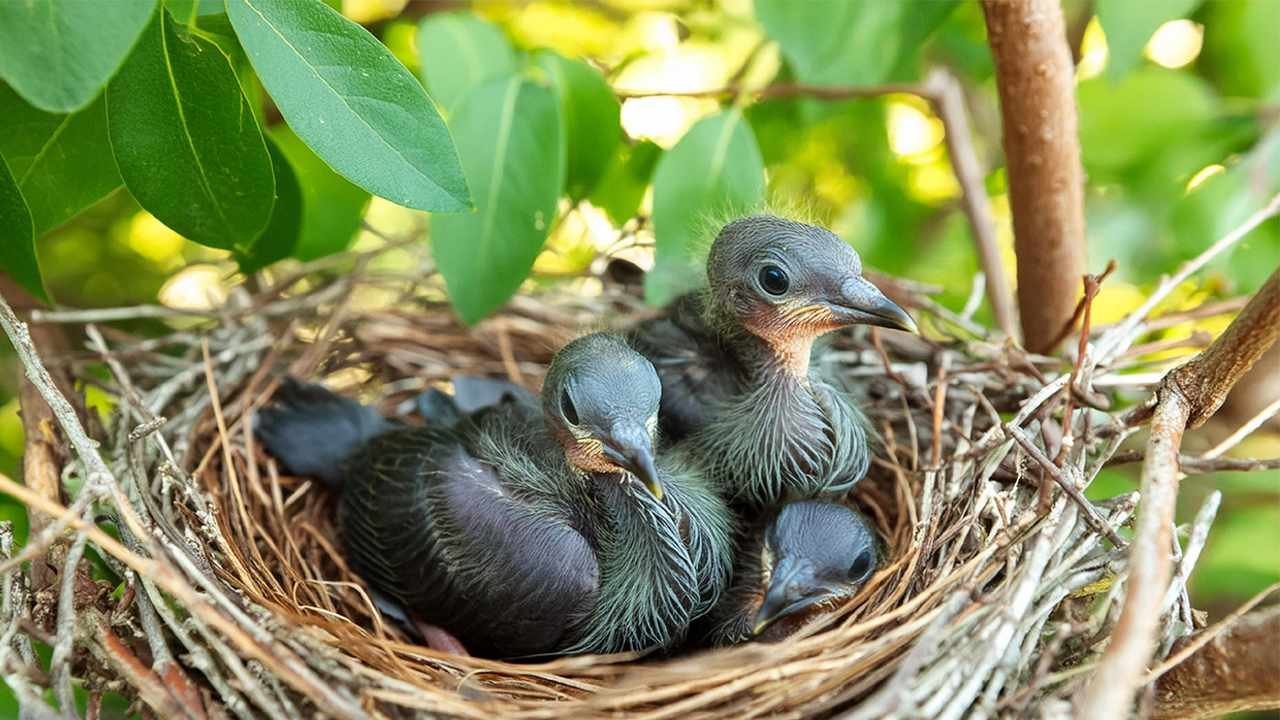Ever taken a walk in a park or around city square, and spotted a bunch of pigeons? You’ll usually see the grown-ups – chubby birds with shiny feathers prancing and cooing. But what about their babies? Unlike lots of birds, baby pigeons, also known as squabs, are quite sneaky. How they look and grow is different from grown pigeons which makes them tricky to notice.
This comprehensive guide unveils the fascinating transformation of a baby pigeon, from its helpless beginnings to its fledgling flight.
Hatchlings: A Glimpse into the Nest
When a baby pigeon first emerges from its shell, it’s a far cry from the familiar gray bird we know. These hatchlings are categorized as altricial birds, meaning they are born in a helpless and undeveloped state.
Here’s a detailed look at what a newborn baby pigeon looks like:
- Size: A newborn pigeon is only about 2 inches (5 cm) long and weighs a mere 15 grams.
- Skin: Their skin is a combination of grayish-pink and dark, lacking the characteristic feathers of an adult.
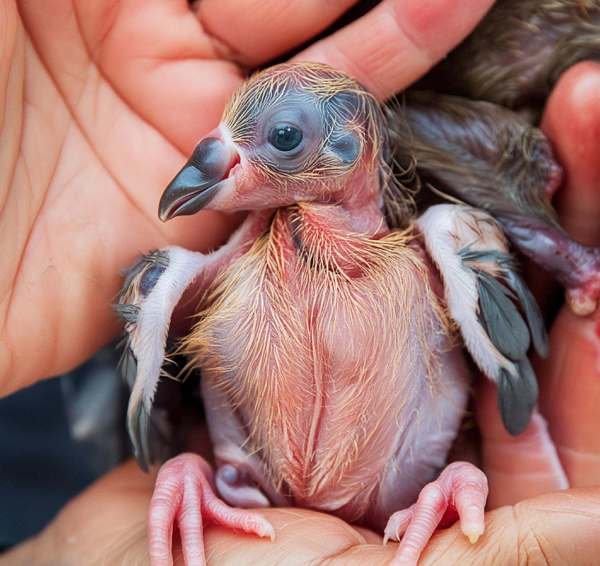
- Feathers: Don’t expect a fluffy chick! Hatchlings have sparse coverage of down feathers, which are fine, hair-like structures. These down feathers are typically yellowish in color and offer minimal insulation.
- Eyes: Newborn pigeons are blind for the first few days of their lives. Their eyes remain closed for about 4-5 days before fluttering open.
- Beak: One of the most noticeable features is their relatively large, pinkish beak. This oversized beak is an adaptation that helps them beg for food from their parents.
- Feet: Similar to the beak, their feet appear large for their body size. These strong feet are crucial for clinging to the nest and eventually perching as they grow.
The Nursery Years: Growth and Development
Over the next few weeks, the squab undergoes a remarkable transformation. Here’s a breakdown of the key developmental milestones:
- Days 1-4: The squab remains mostly immobile in the nest, relying solely on its parents for warmth and nourishment. Their down feathers continue to grow, offering some additional insulation.
- Days 5-7: This is a critical period marked by the opening of their eyes. They become more vocal, emitting begging calls to alert their parents to their hunger.
- Weeks 1-2: The down feathers become denser, and the squab starts to develop pin feathers – the precursors to true feathers. They gain strength and mobility, allowing them to move around within the nest.
- Weeks 3-4: This is an exciting growth spurt! The pin feathers transform into proper feathers, gradually replacing the down. By week 4, most of their body will be covered in feathers, with the head and neck lagging behind. Their beak hardens and darkens in color.
- Weeks 5-6: The squab’s transformation reaches its peak. Their feathers are almost fully developed, closely resembling an adult pigeon in plumage. They become increasingly restless in the nest, practicing their wings for their first flight.
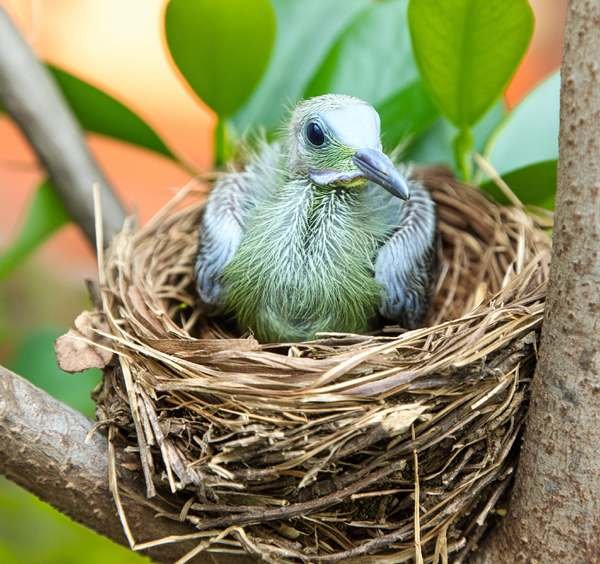
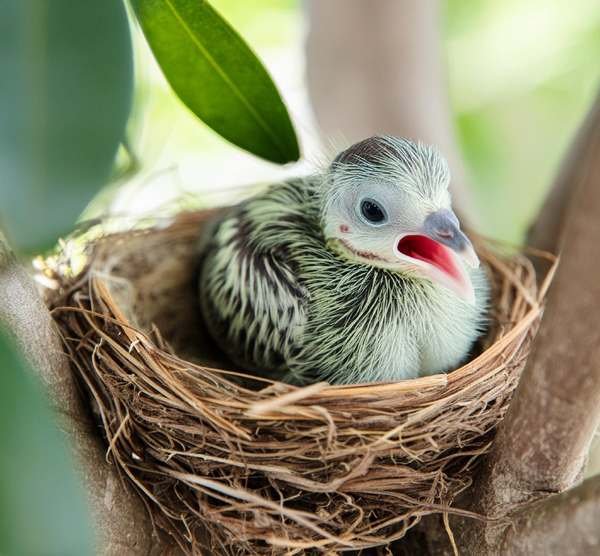
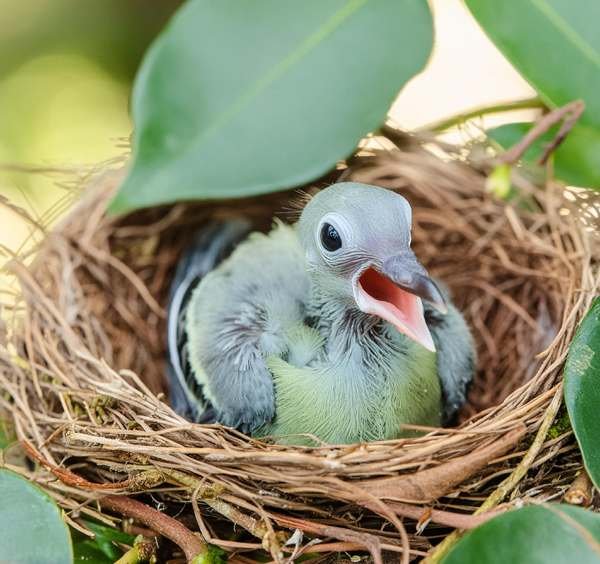
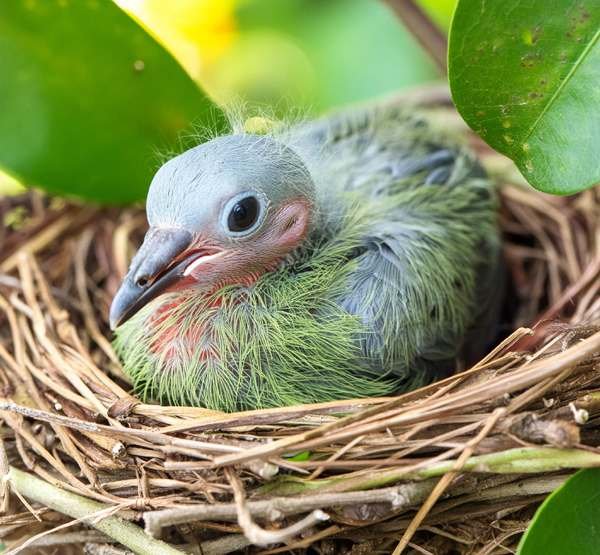
Fun Fact: During this growth period, squabs are fed “pigeon milk” by their parents. This nutritious substance, produced in the crop of adult pigeons, is rich in protein and antibodies, essential for the chick’s development.
Fledging: Taking to the Skies for the First Time
Around 5-6 weeks old, the moment arrives – the squab is ready to fledge! Fledging refers to a young bird taking its first flight. Here are some signs that a squab is preparing to fledge:
- Constant wing flapping: The squab will exercise its wings more frequently, strengthening the muscles needed for flight.
- Increased activity: It becomes more restless in the nest, hopping around and attempting short flights within the nesting area.
- Loss of fear: The squab’s natural fear of heights might diminish as the urge to fly takes hold.
The first flight is often clumsy and uncontrolled. The parents will encourage the squab to leave the nest and may even nudge it off the ledge. However, they stay close by, offering guidance and support during the initial flights.
The Not-So-Little Pigeon: Life After Fledging
While the fledgling pigeon (still sometimes called a squab) closely resembles an adult in appearance, it’s not quite there yet. Here’s what sets them apart:
- Size: Fledglings are smaller than adult pigeons, with less overall body mass.
- Feathering: Their head and neck might still have some down feathers, and the adult-like iridescent feathers on the neck are absent.
- Beak: The beak may still have a slightly pinkish tinge compared to the adult’s dark gray beak.
- Flight Skills: Their flying skills are underdeveloped. They can take short flights but lack the stamina and maneuverability of an adult pigeon.
Following fledging, the young pigeon remains dependent on its parents for several weeks. During this time, the parents continue to provide food and teach the young bird essential survival skills like foraging for food, avoiding predators, and navigating the urban environment.
Here’s a table summarizing the key differences between a fledgling pigeon and an adult pigeon:
| Feature | Fledgling Pigeon | Adult Pigeon |
|---|---|---|
| Size | Smaller, less overall body mass | Larger, more robust body |
| Feathering | Head and neck might have down feathers, lacks iridescent feathers | Fully feathered, with iridescent feathers on the neck |
| Beak | May have a pinkish tinge | Dark gray beak |
| Flight Skills | Underdeveloped, short flights | Strong, sustained flight, maneuverable |
| Dependence on Parents | Relies on parents for food and guidance | Independent |
Beyond the Nest: The Journey to Adulthood
The transition from fledgling to adult is gradual. As the young pigeon practices its flying skills and learns from its parents, it becomes increasingly independent. Over the next few months, the following changes occur:
- Complete Feather Development: Any remaining down feathers are replaced by adult feathers, including the development of the iridescent feathers on the neck.
- Beak Coloration: The beak loses its pinkish hue and becomes a uniform dark gray color.
- Improved Flight Skills: The pigeon’s flight becomes stronger and more controlled, allowing for longer distances and more agile maneuvers.
- Independence: The young pigeon becomes fully independent, no longer relying on its parents for food or guidance.
Factors Affecting Appearance in Baby Pigeons
While the general developmental stages outlined above apply to most pigeons, there can be some slight variations in appearance due to several factors:
- Species: Different pigeon species might have subtle variations in plumage color or patterning, even in the nestling and fledgling stages.
- Nutrition: The quality and quantity of food received from parents can impact the growth rate and feather development of the squab.
- Health: Health issues can affect a pigeon’s development, leading to slower growth or stunted feathers.
Frequently Asked Questions (FAQs)
Why don't I see baby pigeons?
Baby pigeons spend most of their time in the nest, which are often located in secluded areas like ledges, building crevices, or underneath structures. This makes them less visible compared to adult pigeons that are constantly foraging in open areas.
What should I do if I find a baby pigeon?
If you find a healthy fledgling pigeon on the ground, it’s best to leave it alone. The parents are likely nearby and will continue to care for it. However, if the pigeon appears injured or is very young and out of the nest, it might require help. Contact a wildlife rehabilitation center for assistance.
Can I keep a baby pigeon as a pet?
In most areas, it’s illegal to keep wild birds as pets. Raising a baby pigeon requires specialized care and knowledge. It’s best to leave them in the wild where they can thrive under the care of their parents.
Conclusion
Baby pigeons, or squabs, are fascinating creatures that undergo a remarkable transformation from helpless hatchlings to graceful flyers. By understanding their developmental stages and appearance, you can appreciate the wonder of these urban birds. So, the next time you encounter a pigeon, keep an eye out – you might just catch a glimpse of a fledgling taking its first tentative steps towards independence.

